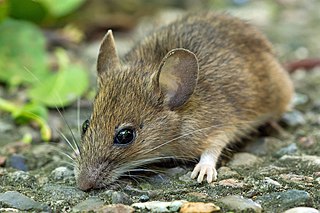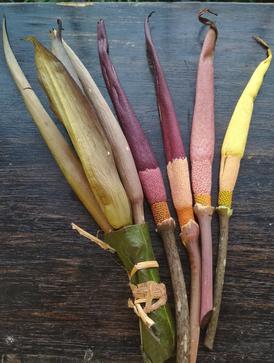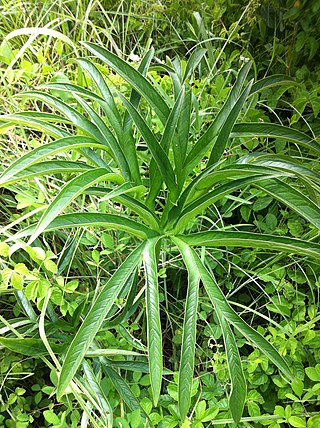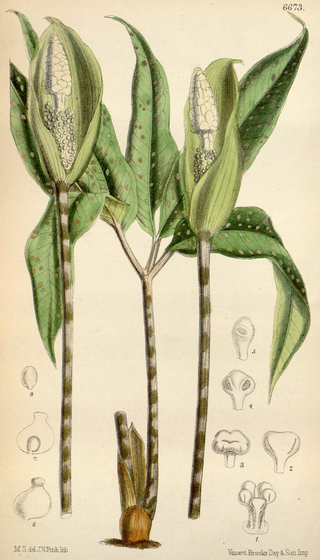
The Araceae are a family of monocotyledonous flowering plants in which flowers are borne on a type of inflorescence called a spadix. The spadix is usually accompanied by, and sometimes partially enclosed in, a spathe. Also known as the arum family, members are often colloquially known as aroids. This family of 140 genera and about 4,075 known species is most diverse in the New World tropics, although also distributed in the Old World tropics and northern temperate regions.

Amorphophallus is a large genus of some 200 tropical and subtropical tuberous herbaceous plants from the Arum family (Araceae), native to Asia, Africa, Australia and various oceanic islands. A few species are edible as "famine foods" after careful preparation to remove irritating chemicals. The genus includes the Titan arum of Indonesia, which has the largest inflorescence of any plant in the genus, and is also known as the 'corpse flower' for the pungent odour it produces during its flowering period, which can take up through seven years of growth before it occurs.

Konjac and konnyaku are common names of Amorphophallus konjac, a vegetable species native to Yunnan in southwest China which has an edible corm. It is also known as konjaku, konnyaku potato, devil's tongue, voodoo lily, snake palm, or elephant yam.

The wood mouse is a murid rodent native to Europe and northwestern Africa. It is closely related to the yellow-necked mouse but differs in that it has no band of yellow fur around the neck, has slightly smaller ears, and is usually slightly smaller overall: around 90 mm (3.54 in) in length and 23 g in weight. It is found across most of Europe and is a very common and widespread species, is commensal with people and is sometimes considered a pest. Other common names are long-tailed field mouse, field mouse, common field mouse, and European wood mouse. This species is a known potential carrier of the Dobrava sequence of hantavirus which affects humans and may pose serious risks to human health.

The Muttart Conservatory is a botanical garden in the North Saskatchewan river valley, across from the downtown core in Edmonton, Alberta, Canada. One of the best-known landmarks of Edmonton, the conservatory consists of three city-operated greenhouses, public gardens, as well as four feature pyramids for display of plant species found across three biomes, with the fourth pyramid hosting a seasonal display. A fifth minor skylight pyramid lights up the central foyer.

Palpifer is a genus of moths of the family Hepialidae described by George Hampson in 1893. There are 10 described species found in south and east Asia and parts of Mexico.

Dracontium is a genus of flowering plants similar to those of Amorphophallus. Unlike Amorphophallus which is found in the Old World, this genus has a New World distribution and is native to South America, Central America, southern Mexico, and the West Indies.

Amorphophallus paeoniifolius, the elephant foot yam or whitespot giant arum, is a tropical plant native to Island Southeast Asia. It is cultivated for its edible tubers in Southeast Asia, South Asia, Madagascar, New Guinea, and the Pacific islands. Because of its production potential and popularity as a vegetable in various cuisines, it can be raised as a cash crop.
Amorphophallus preussii is a species of plant in the family Araceae. It is endemic to Cameroon. Its natural habitats are lowland tropical and subtropical moist broadleaf forests and subtropical and montane tropical and subtropical coniferous forests. It is a Vulnerable species threatened by habitat loss.

Amorphophallus abyssinicus, also known as Bagana (Sidamo), is a plant of the genus Amorphophallus. It is native to southern Ethiopia, where it is grown in gardens, hence its specific epithet, abyssinicus, derived from Latin and meaning "Abyssinian" or "Ethiopian".

Amorphophallus titanum, the titan arum, is a flowering plant in the family Araceae. It has the largest unbranched inflorescence in the world. The inflorescence of the talipot palm, Corypha umbraculifera, is larger, but it is branched rather than unbranched. A. titanum is endemic to rainforests on the Indonesian island of Sumatra.

Amorphophallus commutatus, or dragon stalk yam, is a plant species in the family Araceae. Amorphophallus is a large genus of some 170 tropical and subtropical tuberous herbaceous plants, which includes the world's largest flower, titan arum.
Snake lily is a common name for several plants and may refer to:

Amorphophallus bulbifer is a species of subtropical tuberous herbaceous plant found in Assam; Bangladesh; China South-Central; East Himalaya; India; Myanmar; Nepal.

Amorphophallus maximus is a species of subtropical tuberous herbaceous plant found in Tanzania and Zimbabwe.

Scirpus sylvaticus, the wood clubrush, is a species of flowering plant in the sedge family.

Amorphophallus margaritifer is a species of plant in the arum family Araceae, native from India to Myanmar.

Amorphophallus lacourii is a species of plants in the family Araceae and the monotypics tribe Thomsonieae. Its native range is Indo-China. It is still often known by its synonym Pseudodracontium lacourii, a consequence of Nicholas Edward Brown originally erecting the now obsolete genus Pseudodracontium.

Amorphophallus longispathaceus is a species of corpse flower, of the genus Amorphophallus, native to the southern island of Mindanao in the Philippines and the northern island of Borneo in Indonesia. It produces a tall, single, compound leaf on a thick, fleshy stalk from a big, bowl-shaped tuber. Before a new leaf is produced, mature plants can put up a large, purplish inflorescence that grows to 1 m in height. The multi-coloured elongated spathe, which is triangular with a bell-shaped base, measuring between 30–38 cm (12–15 in) in length and 12–20 cm (4.7–7.9 in) in width, produces an odour similar to that of rotting flesh in order to attract fly pollinators.





















